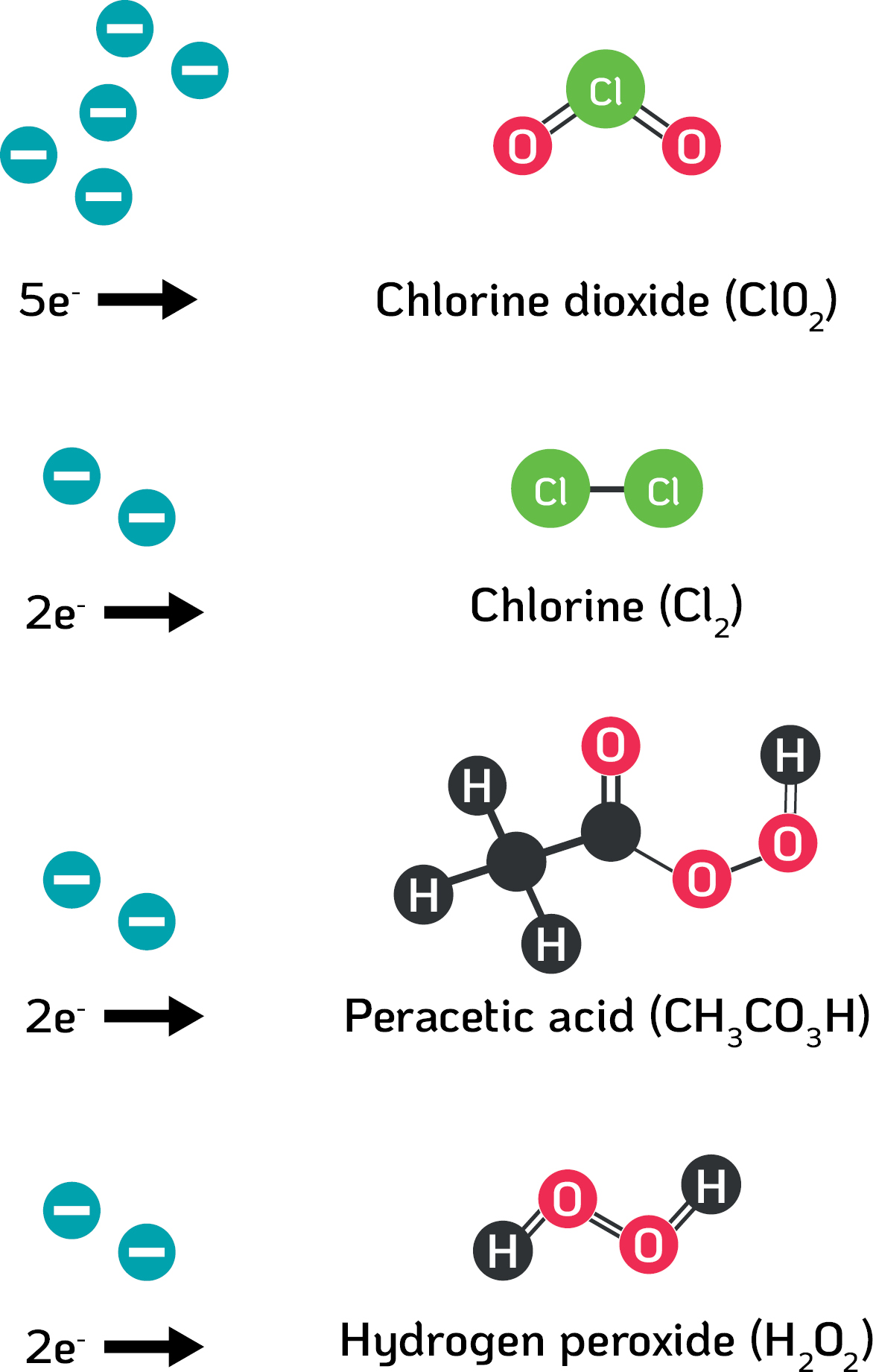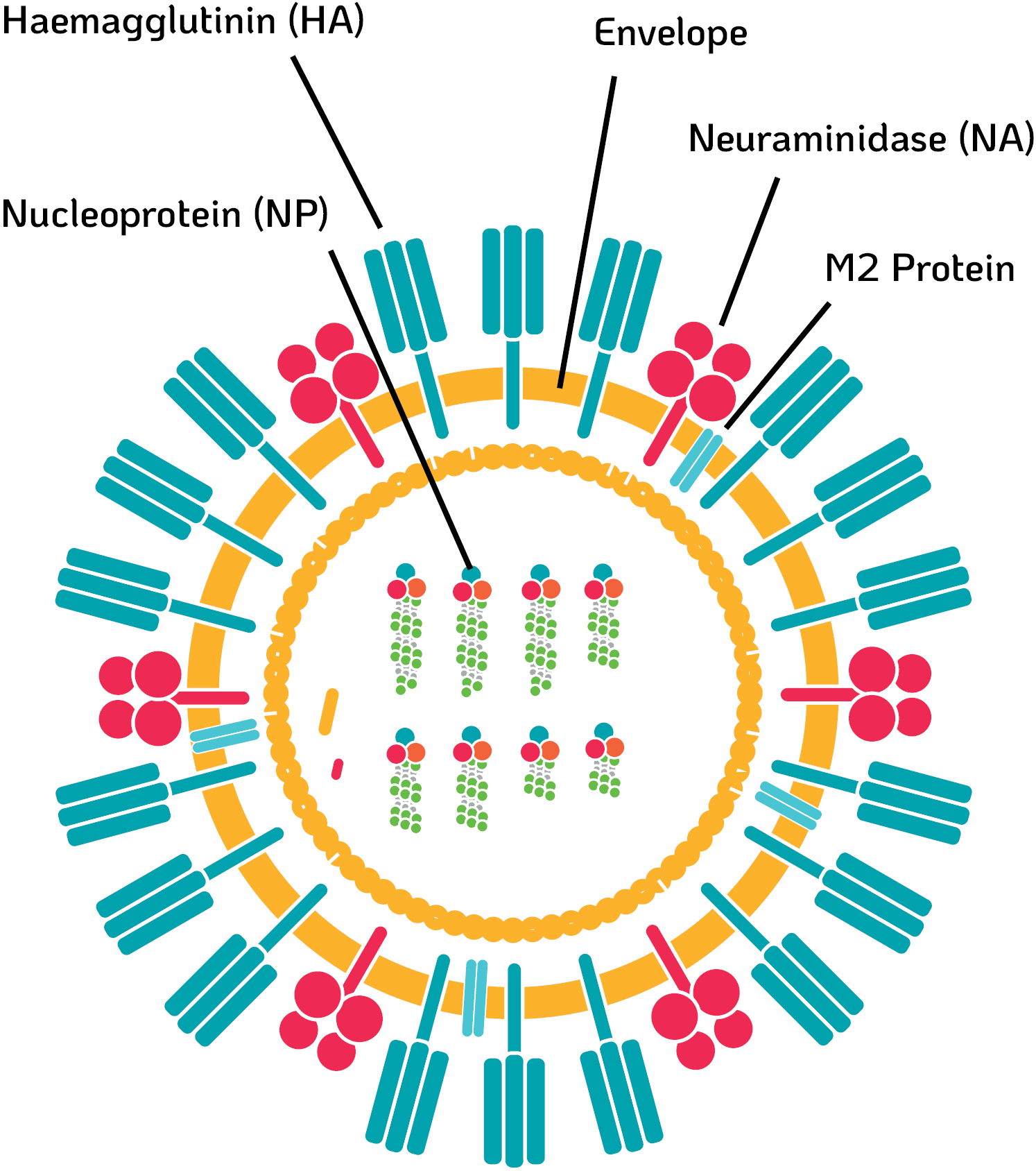Chlorine Dioxide Mode of Action on Viruses
Chlorine dioxide (ClO₂) is a powerful biocide with proven efficacy against a wide range of microorganisms including viruses. Scientific research has been undertaken to understand the virucidal activity and mode of action of chlorine dioxide. Several ways have been identified for viral inactivation by chlorine dioxide, including protein and nucleic acid modification. Understanding the mode of action of chlorine dioxide aids the advancement of products used in infection control.
Introduction
Viruses teeter on the boundaries of what is considered life. Viruses are composed of genetic material, either deoxyribonucleic acid (DNA) or ribonucleic acid (RNA), encompassed by a protein coat called a capsid. Certain viruses are covered by an additional coat composed of lipids and proteins known as the envelope. Viruses are the smallest of all infectious agents. Theoretically, 500 million rhinoviruses (which cause the common cold) could fit on to the head of a pin (Microbiology Society, 2020) (Figure 1). Viruses can only multiply within the cells of other living organisms known as host cells. Therefore, they are referred to as obligate intracellular parasites. Viral infections lead to a myriad of diseases such as COVID-19, Ebola, measles, influenza, hepatitis, polio, and smallpox. The pathogenicity of a virus in humans is determined by viral affinity, entry, and replication in host cells. Inactivating and destroying viruses in the immediate environment is vital in reducing the risk of viral infection. This is mainly achieved by disinfection and following infection control practices where applicable.
Figure 1. A size comparison between a human red blood cell and various microorganisms. Image adapted from the Royal Society of Biology (https://www.rsb.org.uk/biologist-features/158-biologist/features/1490-larger-than-life).
Chlorine Dioxide as a Disinfectant
Chlorine dioxide (ClO₂) has been used in the water treatment industry for the past century. The World Health Organisation (WHO) approves ClO₂ for the disinfection of drinking water. In recent decades, ClO₂ has been shown to be an effective biocide in solution and gas forms with efficacy against bacteria, viruses, protozoa, yeasts, fungi, mycobacteria, and bacterial spores.
ClO₂ is an oxidiser, as it has the capability to obtain electrons from nearby molecules, i.e. viruses. ClO₂ can obtain five electrons in total from surrounding molecules, making it a superior biocide to alternative oxidisers, such as aqueous chlorine, peracetic acid and hydrogen peroxide, which are only able to gain two electrons (Fukayama et al., 1986) (Miura and Shibata, 2010) (Figure 2).
Figure 2. The oxidative capacity of various biocide agents. The oxidation capacity of chemicals denotes the number of electrons one molecule can accept from its surrounding molecules, i.e. microorganisms including multiple part reductions.
The Virucidal Activity of Chlorine Dioxide
Viruses are either enveloped or non-enveloped. According to the Centers for Disease Control and Prevention (CDC), enveloped viruses are regarded by scientists as the least resistant group of microorganisms for disinfectants to inactivate. Vegetative bacteria, fungi, non-enveloped viruses, mycobacteria and bacterial spores are all deemed more resistant for disinfectants to inactivate (Centers for Disease Control and Prevention, 2008) (Figure 3).
Figure 3. Resistance of microorganisms to disinfectants. Adapted from Centers for Disease Control and Prevention (2008).
Tristel’s ClO₂-based disinfectants have been tested in accordance with virucidal standards such as EN 14476 and EN 14675, the European regulatory standards for virucidal activity of disinfectants used in the medical and veterinary area, respectively. In the medical area, Murine Norovirus, Poliovirus Type 1 and Adenovirus Type 5 are chosen by scientists for testing, as they are representative of the most resistant viruses. Efficacy against these viruses and compliance with EN 14476 infers efficacy against all viruses (non-enveloped and enveloped). For the veterinary area, Bovine Enterovirus Type 1 is chosen as the most resistant test virus for efficacy against all viruses. A range of Tristel’s ClO₂-based disinfectants also conform to United States Environmental Protection Agency (EPA) guidelines in accordance with the ASTM E1053 method.
Tristel chlorine dioxide products are featured in infection control studies concerning Human Papillomavirus (HPV) and SARS-CoV-2 (the virus responsible for the COVID-19 pandemic). Meyers, et al., (2020) demonstrates Tristel’s ClO₂-based products, Tristel Duo and the Tristel Trio Wipes System have efficacy against infectious HPV Type 16 and Type 18 on medical devices [endocavity ultrasound probes and nasendoscopes] in a 30-second contact time. In Jerry et al., (2020), Tristel Fuse for Surfaces (a ClO₂-based product) was used in the decontamination process for COVID-19 patient rooms, patient ward areas and nurses’ station areas. This study demonstrates that the use of chlorine dioxide alongside other measures is effective in preventing the spread of SARS-CoV-2 from contaminated patient rooms and general ward areas.
Mechanism of Viral Inactivation by Chlorine Dioxide
Chlorine dioxide reacts with viral components made up of proteins (chains of amino acid residues) and genetic material (nucleic acids). These reactions affect viruses, which leads to their inactivation in several ways. Further research regarding the mode of action of ClO₂ on viruses and how this active molecule specifically interacts with viral molecules continues to evolve in the scientific community.
Mode of Action on Viral Proteins
Unlike other oxidant chemistries, ClO₂ is highly selective, reacting extremely slowly (or not at all) with most organic compounds (e.g. living tissue) which are known to inactivate other oxidising chemistries such as aqueous chlorine. However, ClO₂ reacts specifically with the amino acids: cysteine, methionine, tyrosine and tryptophan, and oxidatively modifies them (Noszticzius et al., 2013).
Ogata & Shibata (2008), demonstrated that ClO₂ treatment leads to the denaturing of Haemagglutinin (HA) and Neuraminidase (NA) on Influenza A virus. Four model peptides (HA1, HA2, NA1 and NA2) were treated with ClO₂, and were analysed by reverse-phase HPLC. Several novel peptide peaks were found on the chromatograms that differed completely from the original peptide peaks; this indicated that the original peptides were modified covalently by reaction with ClO₂. Covalent modification of the amino acid residues of tryptophan and tyrosine by ClO₂ was confirmed by mass spectrometry (MS). Such modifications of amino acid residues appeared to denature the HA and NA proteins of Influenza A virus. These proteins are essential for viral infectivity and denaturing them consequently inactivated the virus.
Figure 4. Structure of an enveloped virus – Influenza virus.
Other peptides were also found to be modified at tryptophan and tyrosine residues; this was suggested to be on other vital proteins such as the Matrix-2 (M2) protein in the viral envelope. The M2 protein of influenza A is a proton channel which balances the pH across the viral membrane during cell entry, triggering the release of the viral genome into the host cell, so that viral replication can occur (Cady et al., 2009). A tryptophan residue protrudes into the M2 protein channel and acts as a gate for protons. As ClO₂ reacts with tryptophan in various peptides, it is likely that the tryptophan residue in the M2 protein channel was also modified by ClO₂, resulting in its key functionality ceasing (Figure 5).
Figure 5. Chlorine dioxide denaturing Matrix-2 (M2) protein. The M2 protein is a proton selective viroporin (channel) in the viral envelope of Influenza A virus. A tryptophan (Trp) residue acts as a gate to mediate proton transport.
Mode of Action on the Viral Genome
It was concluded by Alvarez and O’Brien, (1982), that ClO₂ inactivates polioviruses (non-enveloped) by targeting the viral RNA, therefore, impairing the ability of the viral genome to act as a template for viral replication. Sedimentation analysis of extracts of HeLa cells infected with ClO₂-inactivated viruses showed a reduced incorporation of uridine (one of the four base units which comprise RNA) into new viral RNA. In this study the critical target of ClO₂ was recognized as the viral RNA, consequently resulting in the virus being unable to replicate (Figure 6).
Figure 6. Chlorine dioxide molecules infiltrating a non-enveloped virus (i.e. poliovirus) and reacting with the RNA. Image adapted from (Thurman and Gerba, 1988).
Chlorine dioxide has also been observed to inactivate another non-enveloped virus, Hepatitis A virus (HAV), by simultaneously destroying antigenicity and damaging the viral genome. Antigenicity is the capacity of an antigen (located on the capsid of HAV) to bind specifically with a complementary protein, i.e. host cell receptors. In Li et al., (2004), antigenicity was measured by ELISA (enzyme-linked immunosorbent assay), and the viral genome was analysed by long-overlapping reverse transcription-polymerase chain reaction (RT-PCR) showing that the 5’ non-translated region was damaged by ClO₂. The study concluded that ClO₂ reacted both with the viral RNA and with the viral capsid protein, inhibiting HAV from attaching, penetrating, and replicating in host cells (Figure 7).
Figure 7. Chlorine dioxide molecules reacting with HAV antigens and RNA, resulting in modifications which impair infectivity. Image adapted from (Thurman and Gerba, 1988).
Poliovirus and HAV are both non-enveloped viruses, which are the most resistant to disinfectants. Having efficacy against these viruses infers efficacy against other viruses of similar structure and the less resistant enveloped viruses.
Conclusion
The virucidal activity of chlorine dioxide has been well established by the aforementioned studies and viral efficacy testing according to European and American standards. With this knowledge, the industry is equipped with disinfectants that are tailored for viral infection control. The active ingredient of many Tristel products is a proprietary chlorine dioxide formulation. These products are situated in the Tristel Portfolio for medical instrument decontamination, including the Tristel Trio Wipes System, Tristel Duo OPH and Tristel Duo ULT, as well as the surface cleaners and disinfectants, including JET and Tristel Fuse for Surfaces. Various studies have shown that chlorine dioxide reacts with viruses depending on their molecular composition and structure. As research continues these nuances will be elucidated further.
For references see PDF download. ©2021 Tristel Solution Limited. All rights reserved.







